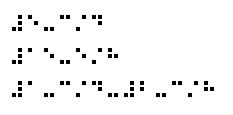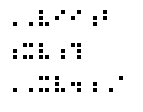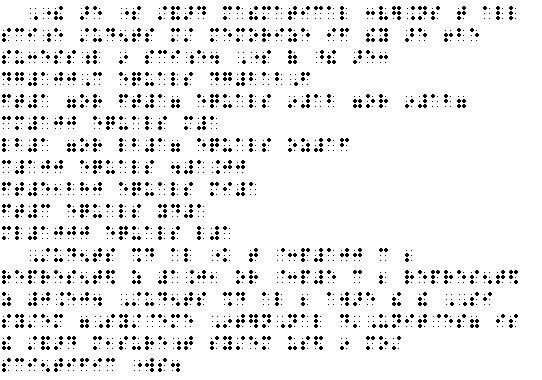|
This reading discusses mathematical and other quantitative constructs as found in literary braille. If you are knowledgeable on the Nemeth Code for mathematics, care must be taken not to use specialized mathematical codes in literary manuscripts.
Fractions and Decimals
Handling fractions and decimals is a very straightforward matter. Fractions can either be represented using the slash or oblique stroke (/, dots 3-4) or with the decimal point (dots 4-6). The use of the slash and the decimal point fundamentally follow that of ink print, with the number sign being used only once at the beginning of the number. There are, however, some specific rules pertaining to "mixed" numbers, such as 5-1/2, 15 5/8, or 1-3/4 - 2-3/8:

The braille for these numbers is:

Notice that the number sign must be repeated in the last example after the hyphen between the first fraction and the second whole number.
Decimal points are represented as they appear in the inkprint. Care must be taken to ensure that the print is using a decimal point and not a period. One area of confusion might be with dates, such as "11.10.97", which should be brailled "11/10/97" as discussed in the previous reading. Note that the decimal sign should also be used for textbook headings, such as "Session 10.1" or "Session 12.4a". Keep in mind that the letter sign is needed before the "a" in the last example.
Mathematical Operations
Recognizing that there is a specific code for mathematics -- the Nemeth Code -- the transcriber needs to make a judgement about the use of the Nemeth code in conjunction with use of Grade 2 literary braille. This section only deals with relatively simple mathematical constructs that appear infrequently in a fundamentally literary text.
In order to avoid the use of mathematical symbols, the basic mathematical operations -- plus, minus, times, divided by, and equals -- are represented by their word equivalents. For example:
8 + 9 = 17 is:

The contractions for "time" in "times" can and should be used, as should the contraction "by", such as in "a 2x4 beam" [read: 2 by 4 beam].
Representing Time
Generally time representations follow that of the inkprint. However, whenever you have time periods (from-to, for example, 3:00-4:15), you should repeat the number sign after the hyphen. This advises the reader that the number after the hyphen is the start of the new time, i.e., the "to" part:

Roman Numerals
Roman numeral representations follow this basic rule:
When the Roman numeral is capitalized, follow standard procedures for single/double capitals
When the Roman numeral is not capitalized (i.e. lower case), the letter sign (dots 5-6) must be used.
Capitals/double capitals are repeated after a hyphen, as is the letter sign. The letter sign also is used in mixed representations, including the addition of "st", "th", and "rd" for ordinal numbers. Examples:

Measurements
A table of symbols used in representing various units of measure is provided for you. Specific braille symbols exist only for:
- the dollar sign
- the percent sign
- the section sign
Most representations, such as "ft" for "feet", are presented by a letter representation. These abbreviations are placed before the number, unspaced and without the period or any plural indication. A sample paragraph and its braille equivalent:
There are some standard mathematical conversions that all science students must memorize if they are to be successful in science. Some of these are:
100° C = 212° F
1 ft. (or 1') = 12 in.(or 12")
100 cm = 1 m
1 lb (or 1 #) = 16 oz
100 cents = $1.00
5,280 ft. = 1 mi.
3 ft. = 1 yd.
1000 ml. = 1 l.
Students should also know that 100% can be represented as 1.0, or 5% can be represented as 0.50. Students should also be aware the the SI system (Système International d'Unités) is the standard measurement system used in most scientific works.
(Note the accent marks on the French terms).

|